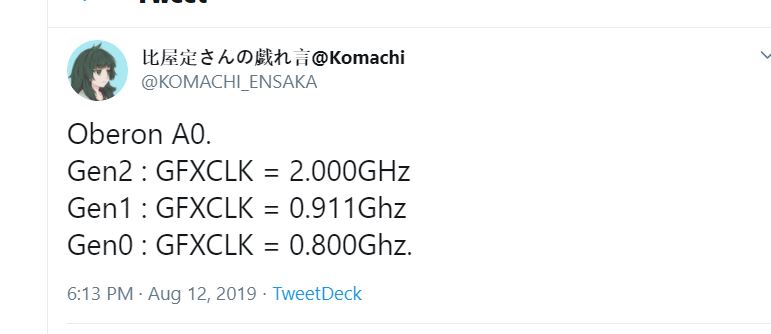| Pemalite said: It will likely be based on the same technology, no point inventing multiple wheels. Using different methods doesn't mean inventing new wheels, it means they are use seperate ways to render the " rays " , even PS4 and Xbox has different methods on applying their API for games. Microsoft heavy emphasis on their directX (for PC compatibility support) while Sony use low level openGL There is absolutely zero evidence to support such an assertion. Cerny explaining how PS4 pro enhanced PS4 games: "First, we doubled the GPU size by essentially placing it next to a mirrored version of itself, sort of like the wings of a butterfly. That gives us an extremely clean way to support the existing 700 titles," Cerny explains, detailing how the Pro switches into its 'base' compatibility mode. "We just turn off half the GPU and run it at something quite close to the original GPU." In Pro mode, the full GPU is active, and running at 911MHz - a 14 per cent bump in frequency, turning a 2x boost in GPU power to a 2.24x increase. However, CPU doesn't receive the same increase in raw capabilities - and Sony believes that interoperability with the existing PS4 is the primary reason for sticking with the same, relatively modest Jaguar CPU clusters. "For variable frame-rate games, we were looking to boost the frame-rate. But we also wanted interoperability. We want the 700 existing titles to work flawlessly," Mark Cerny explains. "That meant staying with eight Jaguar cores for the CPU and pushing the frequency as high as it would go on the new process technology, which turned out to be 2.1GHz. It's about 30 per cent higher than the 1.6GHz in the existing model." Also previous PS5 APU benchmarked leak (Oberon) also indicates that PS5 apu will run with multiple clock speeds based on which's games is running inside the system,
800 Mhz for PS4, 911 Mhz for PS4 pro, and 2 Ghz for PS5 games, As we know Sony does not have the benefit of API and software expertise unlike Microsoft on emulating . Worked with nVidia? No more or less than with AMD. I am talking about gaming PC GPU that available on market for consumer product rightnow, (as of rightnow PowerVR does not available for PC gaming and AMD are not yet has Raytracing). Microsoft are using their expertise on DirectX ray tracing with Nvidia to run on Scarlet, this what might be inside Scarlet That's why I mentioned above, they are using their "Their directX API" for raytarcing support, because they have been working with Nvidia and AMD has not yet has the tech, Sony dont have direct X , they can use Opengl tho support or modified version of Opengl and Vulcan They choose using AMD Tessellation because AMD has the tech already, this time around AMD don't have the tech ready available for 2020, RDNA or even RDNA 2 (probably are not going inside PS5 or Scarlet) are not even confirmed to have ray tracing solution So the API differences are thus ultimately irrelevant. The API is super relevant because every consoles has their own API even Dreamcast and PS2 running on different API, hell even PS4 and Xbox running with different API, maybe some instruction has Directx Tessellator like you mentioned but that doesn't mean all code and instruction running with the same API. RDNA 2.0 is set to have hardware Ray Tracing, it is likely to be the same approach to Ray Tracing that will be in next-gen consoles as RDNA is modular just like GCN. (Which makes sense as RDNA is built on top of GCN's design principles.) We still don't have any confirmation about RDNA 2 to have ray tracing solution. If they have, then PS5 and Scarlet might have the same solution , but like i said if they have one there should have been some major leak and many forum dweller wouldn't have to arguing either PS5 have software based ray tracing or hardware solution (back then they were arguing Microsoft will have Hardware and Sony will not have hardware support for ray tracing for nextgen consoles) We don't know how far the contract between Sony and AMD is and also we don't know how much money and times both company willing to invest on engineered their APU, We have a long history from PS3 and Xbox 360 where they even made a special chip for their consoles, and it has become less costume on PS4 and Xbox One era (due to cost ) etc. It's possible to have another IP inside other IP, Hell even inside AMD Navi alone it has different type of IP that patented by AMD for their tech.
Tensor cores are a patented nVidia technology and thus AMD is not allowed to use it unless nVidia gives the approval. We have the proves and it existed on Surface that has just launching today
Checkerboard rendering is an AMD technology, not a Sony one. Can you give prove to this , because if they has one, it should have been available on RX 480, or RX 580 GPU back then
We have no evidence to support or discredit such a hypothesis. Is more of the implementation, Microsoft kernel can be used for optimization code to metal but due to Microsoft policy (future backcompatibility, the games also should be coming to Windows and Steam) it's impossible for them to run the games close to metal. If it's not a ratified standard that is exposed via OpenGL/Direct X and is thus hardware that is mainstream and supported by all vendors, then it's exotic. For this you may be correct , but for what i have read , PowerVr ray tracing method is not that different than Nvidia path tracing methods. So developer will not have difficulty to implement it on their games. |




















